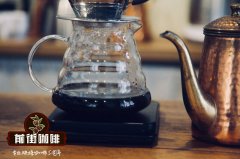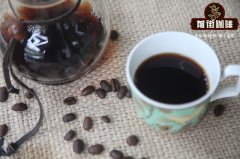What is the planting history of Kenya AA Matilakali treatment plant? Flavor and taste characteristics?

Professional coffee knowledge exchange more coffee bean information please follow the coffee workshop (Wechat official account cafe_style)
What is the planting history of Kenya AA Matilakali treatment plant? Flavor and taste characteristics?
Kenya is a model country for producing fine coffee beans. Coffee was introduced from Britain in 1900. Only traditional Arabica did not have the best bourbon species of SL28 and SL34 in Kenya until 1950. All water treatment methods and graded AA PLUS?AA?AB systems are adopted, but this is only a difference in particle size uniformity and does not represent a difference in quality. High quality elevations range from 4200 to 6800 feet. From 2009 to 2010, due to the influence of global warming and pathological changes, production decreased and prices rose. After that, fine coffee continued to rise and the irreplaceable flavor of Kenyan coffee kept the price of good Kenyan beans at a high price. therefore, direct coffee is the first choice to buy better quality Kenyan beans, larger beans with high wine BlackBerry acid, can be harvested twice a year, April to June is the second production season, October to December is the main harvest season.
Most of the coffee beans are graded by the Kenya Coffee Bureau and sold at the auction venue. The system of public auction can be traced back to the way of auction before 1934. Kenya has 50 licensed agents who send sample beans to their customers for cup testing. Customers can bid for their favorite coffee at the auction. But this approach seems to encourage intermediary agents to erode farmers' incomes, so in 2006 Kenya opened 32 more independent sales agents to contact foreign coffee buyers directly without going through auctions. but all of these have to reach the quality of the Kenyan Coffee Agency? Storage? Only standards such as bank guarantees can be sold, and the two systems operate in parallel at the same time. After several years of development, it is the most transparent auction distribution system. The better the coffee quality is, the better the price can be measured through the cup, so that more cooperatives and farms are willing to join. However, I think the latter can contact farmers directly to get first-hand information.
The Madirakali treatment plant is located in the Nyeri production area in western Kenya. It began operation in 1951 and produced about 3666 bags of 220000 kg in 2011. It is expected to produce about 5800 bags of 350000 kg of red cherries next season. It is a small treatment plant. Only farmers pick fully ripe red cherries by hand, deliver them to the treatment plant immediately on the day of harvest, remove the peel and pulp, and then ferment for 16 hours to clean the surface mucous membrane. This is the key procedure to maintain a thick, sturdy black acid, and the price of coffee beans is determined here, so more and more Kenyan beans choose to do this important procedure in small processing plants, because only fresh can have good quality.
In April 2012, Direct Coffee introduced PB beans from Mathira Kariea Matila Callie processing Plant, and the response was very good. This time we re-introduced Kenyan AA grade coffee beans!
Farm characteristics
Farm Farm
Name: AA beans of Mathira Kariru Matila Callie processing Plant
Grade: AA
Country: Kenya Kenya
Region:Central Kenya, Mathira West District, Kirimukuyu division, Karie location
Altitude: 1600-1700 m
Farm size: small coffee farmers who grow in small areas
Soil soil: Red Volcanic Loam soils volcanic clay
Collection method: Hand picked harvested by hand
Certification: Fair Trade Fair Trade Association
Variety: SL 28, SL 34, Ruiru 11
Treatment: Full Washed washing drying on African viaduct
Important Notice :
前街咖啡 FrontStreet Coffee has moved to new addredd:
FrontStreet Coffee Address: 315,Donghua East Road,GuangZhou
Tel:020 38364473
- Prev

Kenya AA Kirinijaga Kenyan AA Flavor introduction
Professional coffee knowledge exchange more coffee bean information please follow the coffee workshop (Wechat official account cafe_style) Kenyan coffee is most famous for its adorable sour taste, here is a quick introduction to today's protagonist: Kenya AA! Coffee introduction the African region has always been one of the best coffee producers in the world, with charming acidity and aroma.
- Next

Kenny AA (Kirinaga) introduction to the flavor characteristics of Kenny AA in Kabare Farmers' Cooperative
Professional coffee knowledge exchange more coffee bean information please follow Coffee Workshop (Wechat official account cafe_style) Kenny AA+ (Kirinaga) Kabare Farmers' Cooperative country: Kenya region / region: Kilinaga East, Central Kenya, Kabare Farmers' Cooperative average annual output: 350000 kg coffee raw bean process: selective manual picking
Related
- Detailed explanation of Jadeite planting Land in Panamanian Jadeite Manor introduction to the grading system of Jadeite competitive bidding, Red bid, Green bid and Rose Summer
- Story of Coffee planting in Brenka region of Costa Rica Stonehenge Manor anaerobic heavy honey treatment of flavor mouth
- What's on the barrel of Blue Mountain Coffee beans?
- Can American coffee also pull flowers? How to use hot American style to pull out a good-looking pattern?
- Can you make a cold extract with coffee beans? What is the right proportion for cold-extracted coffee formula?
- Indonesian PWN Gold Mandrine Coffee Origin Features Flavor How to Chong? Mandolin coffee is American.
- A brief introduction to the flavor characteristics of Brazilian yellow bourbon coffee beans
- What is the effect of different water quality on the flavor of cold-extracted coffee? What kind of water is best for brewing coffee?
- Why do you think of Rose Summer whenever you mention Panamanian coffee?
- Introduction to the characteristics of authentic blue mountain coffee bean producing areas? What is the CIB Coffee Authority in Jamaica?

